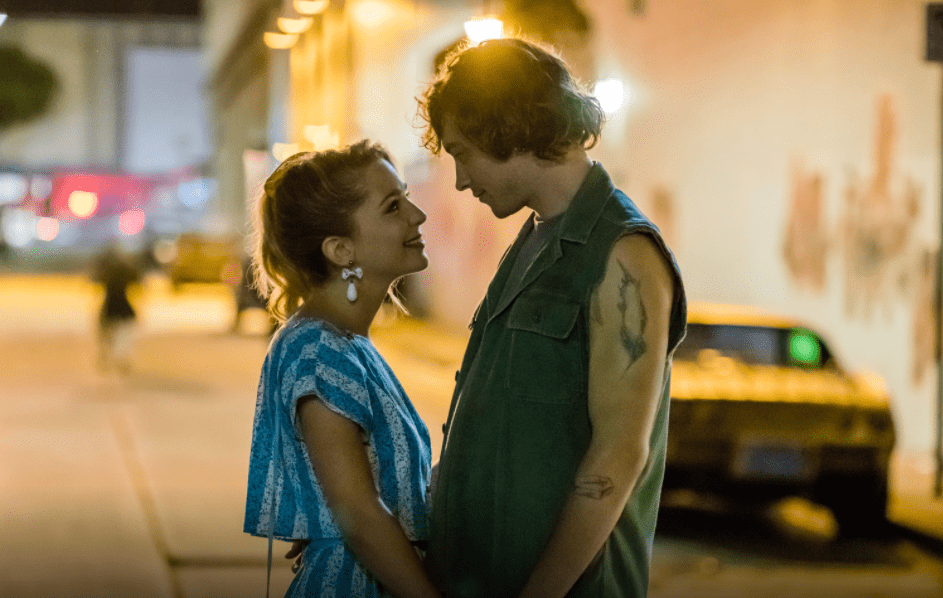
It’s safe to say that nobody was clamoring for a remake of 1983’s Valley Girl. Set in (then) contemporary Los Angles, it paired a subdued (by today’s standards) Nicolas Cage as a Hollywood bad boy and Deborah Foreman as Julie, the titular girl of the San Fernando Valley. The original was a pleasant enough teen romance most memorable for introducing that unique Valley patois to the rest of America and a soundtrack of full of New Wave radio hits. Director Rachel Goldenberg’s new version takes those elements and heightens them, turning Valley Girl into an ‘80s pastiche that not only goes full musical, but adds surprising depth to the story.
Writer Amy Talkington’s script begins by justifying the ‘80s setting with a framing device wherein present day Julie (Alicia Silverstone) tries to comfort/impress her recently-heartbroken daughter (Camila Morrone) with the story of her first love. While it’s borderline insulting to have the former Miss Cher Horowitz (who would have turned 7 in 1983) in the role, Goldenberg is almost certainly using her casting and the soundtrack’s inclusion of “Kids in America”–which also plays in Clueless–to draw a line between that iconic teen comedy and hers. Like that film, Theresa Guleserian’s production design is colorful and a little absurd. It’s not trying to recreate the realistic-ish fashions from the original Valley Girl, but an idealized version from Julie’s memory.
So, it’s precisely because what we see is supposed to be a memory that the film can get away with not only delivering a cartoon version of the ‘80s, but convey nearly every plot point and character trait through a musical number. The film’s first number, a cover of The Go-Go’s “We Got the Beat” is set in that bastion of suburban life: a mall. As young Julie (Jessica Rothe) and her friends Karen, Loryn and Stacey (Chloe Bennet, Ashleigh Murray and Jessie Ennis, respectively) dance and sing their way through the stores, it’s impossible not to get swept up in their and the film’s energy and it basically retains that momentum through much of its first half by giving us one number after another.
Still, while the production design and La La Land choreographer Mandy Moore’s work generate a lot of that energy, the perfectly-chosen cast is equally responsible for keeping the audience engaged. Bennet is perfect as the mean girl of the group and nearly steals the movie during a workout studio number set to a mash-up that includes “I Just Can’t Get Enough,” “Tainted Love” and “Material Girl.” Judy Greer is as effortlessly brilliant as ever as Julie’s uptight, but clearly yearning for more mother. Even Logan Paul (who is the reason film’s release was delayed two years) is perfect as Julie’s self-centered, obnoxious valley boyfriend. Every character gets at least one major moment to shine and it’s perhaps because the film is such an ensemble piece that Rothe as the straight man doesn’t quite stand out as much as she might have.
That said, Rothe is by no means bad here and in fact does fine work grounding the film in–if not reality–than real emotions. As effervescent as Rothe is in that first number, she also plays Julie as a girl who already seems to understand that there’s so much to experience outside the small circle of her valley life. Julie may be set to go to Cal State Northridge with her friends in the fall, but she also has secret ambitions of becoming a fashion designer. So, when Josh Whitehouse’s Randy comes along in his leather jackets and tattoos, he’s not so much her introduction to a different lifestyle, but her gateway to becoming who she already wants to be.
However, while Rothe and Whitehouse’s instant chemistry is strong enough to make the film’s love story just as convincing as the original, it’s the ways Goldenberg and Talkington alter the story slightly that elevate Valley Girl. The original film’s conflict basically boils down to will Julie realize her valley life is vapid and suffocating, but this version doesn’t dismiss or talk down to Julie for caring about things like prom or having her parents and friends accept Randy. Rather, it starts from a premise of women contain multitudes and explores every female character–even villains–from that premise. In one of the film’s best scenes, Julie reprimands Randy after he causes a scene in front of her friends, pointedly asking him why she’s expected to integrate into his world while he doesn’t have to do the opposite for her. It’s a really satisfying moment and one so rarely seen in teen romances especially and the film’s last act is filled with choices that twist clichés to reflect how feminism has evolved since 1983.
Granted, there are elements of that change in viewpoint that feel heavy-handed (a pretty cringeworthy conversation about astronaut Sally Ride, for instance), but overall, Valley Girl feels almost like a corrective to years of rom-coms that put women down just as often as they uplift them. Yes, Julie and her friends can be shallow or short-sighted, but the film never dismisses even their pettiest concerns, arguing instead that these girls are just as entitled to figuring things out and messing up as generations of male characters. Perhaps those changes and shifts in viewpoint seem small in the grand scheme of things, but they feel revolutionary in a genre not prone to taking chances.

